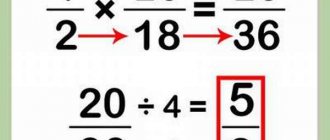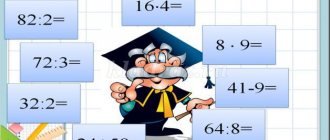- home
- Directories
- Handbook of mathematics for elementary school
- Division
In this section, we will become familiar with division and learn that division is the mathematical operation inverse to multiplication.
Multiplication is the sequential addition of numbers, and division is the sequential subtraction of numbers.
In mathematics, there is a sign for multiplication - this is a dot ( • ) in the middle of the line between the numbers that need to be multiplied, and for division there is a special sign - these are two dots ( : ) between the numbers that need to be divided among themselves.
How can hedgehogs divide apples equally among themselves?
You need to use the operation of division and find out how many times 3 is contained in 6.
1) 6 : 3 = 2 (jab) - we found out how many apples each hedgehog will get.
2) 6 : 2 = 3 (hedgehog) - we found out how many hedgehogs will receive 2 apples.
3) 2 • 3 = 6 (yab.) - we found out how many apples are needed so that each of the three hedgehogs has 2 apples.
Any multiplication example can be represented by two division examples.
For example, for the expression 6 • 4 = 24 there are two inverse expressions:
24 : 4 = 6 — you need to subtract the number 4 from 24 exactly 6 times.
24 : 6 = 4 — you need to subtract the number 6 from 24 exactly 4 times.
Numbers when dividing
In division, as in other mathematical operations, each number has its own name.
The number that is being divided is called the dividend .
The number that is divided by is called a divisor .
The result of division is called the quotient .
Reading Numeric Expressions
24 : 6 = 4
This example can be read in different ways.
- 24 divided by 6 equals 4.
- Reduce 24 by 6 times - you get 4.
- The dividend is 24, the divisor is 6, the quotient is 4.
- The quotient of 24 divided by 6 is 4.
Division by 1
4 : 1 = 4
23 : 1 = 23
Division by 0
Dividing a number by itself
Relationship between division and multiplication
Even and odd numbers
Numbers that are divisible by 2 without a remainder are called even, and numbers that are not divisible by 2 without a remainder are called odd.
Even: 6, 22 44, 60, 74, 82, 96
Odd numbers: 7, 13, 21, 37, 45, 97
Several times less
For example, let's solve the problem:
There were 8 kittens in the store, and 4 times less foxes. How many chanterelles were there?
Let's make a diagram:
This means that to find out how many chanterelles there were, you need 8: 4 = 2 (l.)
Conclusion: If the problem contains the words “... times less,” then the problem can be solved by division.
How many times more? How many times less?
For example, let's solve the problem: There were 8 kittens and 2 foxes in the store. How many times were there more kittens than foxes? How many times were there fewer foxes than kittens?
To answer these questions, you need to find out how many times 2 are there in 8 ?
8 : 2 = 4 (times)
This means that there are 4 times more kittens than chanterelles, and 4 times fewer chanterelles than kittens.
Share with friends on social networks:
We will help you learn the multiplication and division tables easily and simply
Agree that it is simply wonderful when a child has an excellent memory, and he himself quickly and easily remembers all the examples of the multiplication table. But this doesn't always happen. And this does not always indicate that the child understands what he was taught.
Let's talk about how to help your child master the multiplication tables without suffering and even while playing.
There is a huge amount of material on the Internet on ways to memorize the multiplication tables, but, as a rule, they are not systematic. In this article we bring to your attention a step-by-step algorithm for mastering multiplication and division.
STEP 1. We study the meaning of the action of multiplication
Before learning the table, you need to make sure that the child clearly understands the meaning of the action “multiply”. If this is not the case, then it’s time to tell us that multiplication is the addition of identical numbers.
Try dictating to your child a long, very long example like 2+2+2+2+2+2…+2= so that he has to write it down on at least two lines. Is it convenient to write such examples? Most likely he will answer: “No!” And he will be absolutely right.
In the first lesson of the School of Special Agents. Supercounting" we help children understand what multiplication is with the help of a short video lesson, and then reinforce the topic using a special interactive simulator.
Did you watch the lesson? Then complete the training mission!
To do this, drag examples from the column on the right into the required boxes under the illustrations.
For example, under the illustration with octopuses you need to drag the example 6+6 (you took 6 twice). When you're done, click the "Check" button.
STEP 2. Swap the multipliers
Now our task is to look at “multiplication” from different sides and derive the most important rule of multiplication!
Look closely at the illustrations below.
It’s interesting that there are 6 fish in the aquariums in the first and second illustrations. The number of fish is the same. But what is different then?
Certainly! In the first case, we got 3 fish 2 times, and in the second case, on the contrary, we took 2 fish 3 times.
When saying with your child “they took two three times,” draw his attention to the fact that “they took three twice” is completely different, although the result is the same. Let's put this step into practice.
It turns out that by rearranging the factors, we simply get the same result in a different combination!
Below we offer two games to review the topic (games from the course “Special Agent School. Super Counting. “Multiplication and Division”)
And now... attention! Although the multipliers have changed places, the result will be the same! (as in the case of fish)
Drag the answer to the desired field and click “check”:
Wonderful! Having mastered this step, students of the “School of Special Agents. Superscore" move on.
STEP 3. Look at the table closely
Being confident that the child understands perfectly what “multiplication” is, you can finally show him the table. It is possible to begin the consideration with a historical note that the table was invented a very long time ago.
Previously, in India the table was taught up to the example 20·20, but in the UK they still teach it up to 12·12, and that our children are very lucky, because in Russia it is enough to remember the table up to 10·10.
After this, you can together count how many examples fit in such a table and find out that there are only 100.
Then, look closely at it again and find 45 examples whose answers are repeated (for example, one from a pair of 3*4 and 4*3). After all, we know that the factors change places, but the answer remains the same. So, there are 55 examples left to learn!
Now we look at multiplication by 1 and 10 and understand that you don’t even need to learn it, it’s so simple. (children practice the strategy “Multiplying by 1” already on the first day of the course “School of Special Agents. Super Counting”)
Thus, out of 100 examples, only 36 (!) original ones remain that should be remembered. To make these 36 examples more clear, ask your child to draw them in the form of a pyramid.
STEP 4. Remember the table
Now, finally, the time has come to get down to business. At this stage, you just need to learn the table, although it seems that this is not easy to do. Cards and board games will help with this.
Memorization techniques can be very diverse: from a homemade adventure game with tasks from the multiplication table to the Memory game. There are many options here, you can choose according to your taste.
The main thing is to memorize intensively, in isolation and always with feedback!
At the School of Special Agents. Super Counting" children easily memorize the multiplication and division tables, and then learn strategies for off-table division and multiplication. And thanks to simulators, they can test their knowledge in an interactive form.
Try it too. Give your answer, then click “rotate” on the card and test yourself.
When memorizing your multiplication tables, it is important to note useful strategies that can make multiplication easier:
Multiplying by 2 is doubling the number, i.e. 7·2 = 7+7; - multiplying by 4 is doubling the number and then doubling the result, i.e. 6·4 = (6+6)·2; — multiplication by 5 is half of multiplication by 10, i.e. 8·5 = (8·10):2; - multiplication by 9 is multiplication by 10 minus the number itself, i.e. 9·9 = 9·10 - 9.
These simple tips will once again remind the child of the meaning of multiplication and help make the memorization process more conscious.
Step 5. Repetition and consolidation.
At the final stage, when the entire table has already been mastered, and you just need to consolidate the material covered, entertaining real-life problems like these are perfect: - how many wheels do 4 cars have? — how many wings does a flock of 9 birds have? - How many toes do 8 people have on their right feet?
A great way to challenge yourself is to fill an empty pyramid against a time limit. And the faster this happens time after time, the more pleasant it will be for the child to see his result!
You can also play the game “find the numbers from the 6 multiplication table”
The main rule is to practice regularly, be sure to repeat previously studied examples from the multiplication table, play and, of course, measure the result.
In the program “School of Special Agents. Super Score" in addition to video lessons, we added daily interactive simulators, a repetition and reinforcement system, a progress scale, and of course, many exciting missions.
With these strategies, children will easily remember not only the multiplication and division tables, but also master non-table multiplication.
Enroll your child in the School of Special Agents. Super account. Multiplication and division" and in 30 days in a convenient format, the child will learn the multiplication table, remember the division table and learn to multiply and divide outside the table.
We have great news! Your child can complete only one level of the program or three at once.
To do this, when placing an order, you must select which program you want to purchase: “Addition and Subtraction”, “Multiplication and Division”, “Common Fractions” or all three at once.
The programs now have the best prices.
Master the multiplication table without pain and learn with pleasure.
enroll your child in special agent school. super account >>>
All learning takes place according to a system of small steps, which means that children do tasks every day and are involved in the learning process!
Enroll your child and we will help him fall in love with mathematics, learn the multiplication tables and count without mistakes:
Did you like the article? Save it to your wall so you don’t lose it





